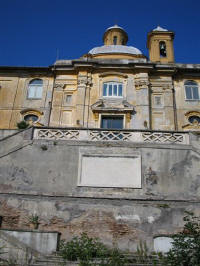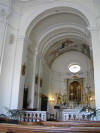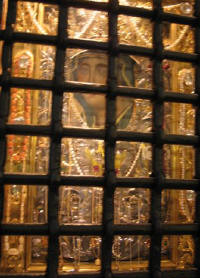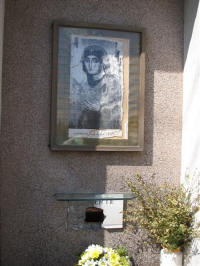Wonders of Rome
The Madonna with Golden Hands
This ancient and long-revered icon, so hard to find, and usually as invisible
as the nuns who keep her behind their chapel grille, well rewards a Sunday climb
up Monte Mario.
The painting represents the Virgin as Advocate
(Madonna Avvocata), without child, hands
interceding with God. Tradition generally ascribes the portrait to St. Luke,
though Pope Sergius III termed it "acheropita," not made with hands; art historians date it to the
500s, making it one of the few such images known to have survived Byzantine
iconoclasm.
| After Emperor Leo III banned the veneration of religious images in 730, many
artisans, monks, and nuns fled Byzantium for Italy, bringing their beloved icons
with them. In the church of
S. Gregorio Nazianzeno in Campo Marzio, founded by refugee nuns, a fresco depicts
Christ directing three brothers to carry the Madonna Avvocata from Constantinople
to Rome. Legend held that an exile named Tempulus, living near the Greek
monastery of Santa Agata on the slope of the Celian Hill, donated the icon and
with it his name to the
monastery chapel, which became known as Santa Maria in Tempuli, though that name could
as well refer to its location on the site of a shrine to Apollo.
In 905, Sergius III moved the image to the papal basilica of St. John Lateran,
but before morning it returned
unaided to S. Maria in Tempuli, where it remained until 1220, when nuns from S.
Maria bore it to their new convent of San Sisto, not far away.
The Madonna remained with the Dominican sisters when they moved to a newer
building nearby in the 16th century and to Monte Mario in 1931, to the convent
chapel of Santa Maria del Rosario, where it is today.
If you walk up from the Vatican area below, you have quite a pilgrimage. Via
Trionfale becomes a steep, winding road without sidewalks. You walk in the
gutter and hope no one hits you. Where you see mysterious steps leading up into
the woods, take them; they're pedestrian shortcuts, safer than the road.
|
 |
| However you get there, you won't find S. Maria del Rosario church at its
street address of via Trionfale 175. That entrance has been closed and the
number removed. A little farther up is a piazza with stairways leading to a
street above, via Alberto Cadlolo. Turn left on that street and look for a
narrow walkway on the left, between the piazza and the convent. Follow the
walkway around to the back of the convent.
The church facade now overlooks the
weedy drive and stairs that used to bring pilgrims from via Trionfale. But the
interior is crisply beautiful.
|
 |
| The icon is in the sanctuary area, to the left of the altar. At any time
other than Sunday between 10:30 and 12:30, it is indiscernible behind the
grille, jeweled metal sheath, and protective, glare-struck glass. These
coverings hide the fact that much of the original painting is gone, and
possibly prevent further erosion. Sunday mass begins at 11:00. Shortly beforehand, the
nuns light the Madonna, so that her face is now visible. But the rest of her
is still hidden behind jewels (right). With her sisters, she watches the
holy sacrifice through the grille. And then, after communion, they remove
the sheath. People come forward to pray and see her arms and her lifted
hands, covered in gold gloves to signify her helpfulness through the ages,
her power to mediate between earth and heaven.
If you're me, you don't use your camera right
then. You're merging with the divine and eternity. You can't tell if you're
praying or listening and wouldn't know whether to record or play.
But when you leave, retracing your steps along
the narrow way, you see a wall shrine with a paper image of the Madonna
unveiled. That's recordable.
|
 |
 |
|